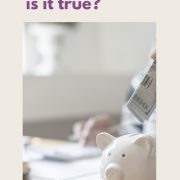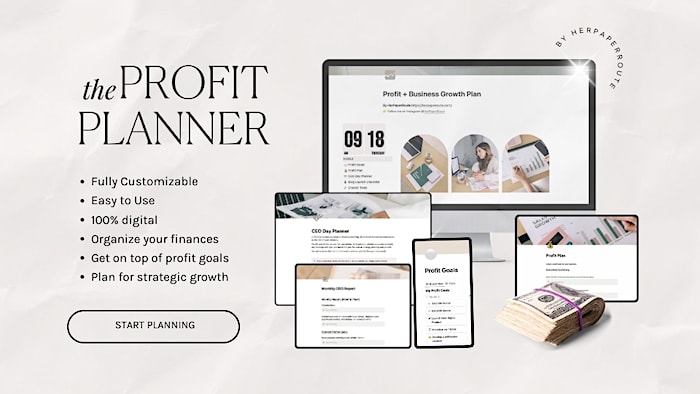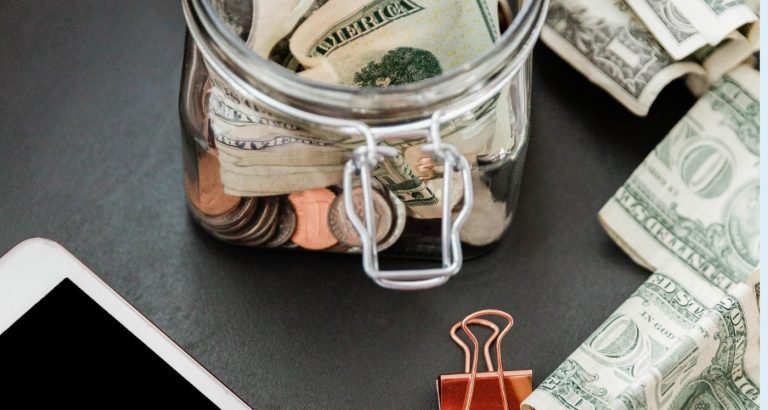The More You Buy, The More You Save: True or False?
There’s a popular phrase that says, “The more you buy, the more you save.”
At face value, this can seem a little counterintuitive—after all, savings is all about spending less money in the first place. That’s what we’ve been taught to believe.
But, is there some truth to saving more by buying more?
Below, we’ll explore the real meaning behind the phrase and how you can apply this principle to your life.
As an affiliate partner of various brands and sponsored content, HerPaperRoute may earn commission on qualifying purchases. Disclaimer | Advertise With Us
A Broader View of Savings
Many people approach savings from one dimension. To them, it is merely the percentage of their income that they put away each month, preferably in a separate savings account.
With this limited view, the only way you can save money and beef up your savings account, so to speak, is to cut down your spending.
You have to reevaluate your budget, increase your monthly savings percentage, and possibly cut out any expenditure that you deem excessive or unnecessary. These actions could be for the short-term or as a permanent decision.
That’s not to say that there’s anything wrong with saving money this way. These are methods I routinely apply myself and recommend to anyone getting started on their savings journey or trying to save up for a major financial goal.
Perhaps you want to put money away towards a new car, or you’ve realized that you desperately need to set up an emergency fund for unforeseen expenses.
I highly recommend that you cut out some items from your budget and get a little more frugal for the next few months. Buying less, using less, and spending less can help you achieve your savings goals faster than you had hoped.
I also suggest that you take a look at the other side of savings, which is a longer-term view of your spending decisions. Let me give a simple example to illustrate a point.
Say you want to buy some tomatoes. You’ve run out of these and have an immediate need for more because the recipe you’re using for dinner tonight requires ripe tomatoes.
In the tomato example, you can approach savings in a few different ways:
- If you’re really frugal, you could decide to forgo the tomato in the recipe altogether. This could work if you have a tomato substitute at hand or your savings goal is that critical to you.
- You could save money by buying the cheapest tomato you can lay your hands on. This is another approach to savings, but it’s important to note that cheaper is not always better with the most substantial products and services.
In fact, while it might seem like you’re winning because you found a more affordable version of a particular product, it might not work out that much cheaper in the long run.
- Another way to save is to consider buying a pack of tomatoes. You only need one tomato, but you decide to get more because it makes more sense in the long-term due to the lower cost per item.
The third savings approach advocates that you take a view of savings that extends beyond your immediate needs and expenses.
With every decision you make to buy or not to buy, you should think about the impact of that expenditure in a few days, weeks, months, or even years. After all, savings is a long-term play, but it’s all too easy to be caught up in a short-term perspective towards it.
To keep a close eye on your savings, check out this free online Savings Planner.
The Power of Volume
There’s something special about more—doing more, making more, buying more, and having more time. Taking advantage of volume, compounding, and leverage can have a massive effect on your life and financial position.
Consider the impact of volume for a production facility. Something spectacular happens to the amount of effort, time, labor, and other resources used to produce one unit when production is ramped up.
When the scale of operations increases, enterprises can take advantage of economies scale, which leads to a decreasing unit cost of production.
Sellers might also take advantage of volume by offering bulk discounts to their customers. Customers drift towards the discounts and savings they get when they purchase a larger pack or multiple items.
The seller also wins because they close more sales, and although their profit per unit decreases with the discount amount, they still make more sales and profit.
This is much better than having full-price stock sitting on the shelves. This strategy is frequently used in closeout and end-of-season sales.
Remember the Opportunity Costs
Before I get into some practical examples of how you can save more by buying more, I have to give a word of caution. Make sure you consider the opportunity costs involved before leveraging the power of volume.
In this case, the opportunity cost is simply what you could have used the money for something else had you not chosen to buy more.
In my previous example, the opportunity cost is what you lose out on when you choose to buy a pack of tomatoes instead of just the one you need. If you have other pressing needs and expenses, make sure you evaluate each alternative, in turn, to see which makes more financial sense.
There’s no point in buying more of one thing under the guise of saving money when you could have used the money to pay off a hefty debt accruing a high interest.
Getting out of debt should be a priority, especially when the interest you pay is greater than the returns on any of your investments and savings initiatives.
How to Save More by Buying More
It’s time to look at some practical ways to apply the concept of buying more to save more in your own personal finances. When you utilize any of these six techniques, you can get immediate savings, but you might only fully realize the benefits in time.
1. Make Use of Bulk Discounts
If you see a store offering bulk discounts on an item you use often, you can buy a large quantity to save money. Doing this works best with non-perishable items such as toilet paper, condiments, and cleaning materials.
When it comes to food items such as vegetables, fruit, and bread, you should be careful not to buy more than you can consume before these items go bad.
You might need to visit a large store that sells in bulk to find these types of discounts. Sometimes, the deals are advertised as such or just factored into a larger pack item’s selling price.
You can even apply this method to small purchases such as a crate of eggs, cooking oil, or a bag of rice. If you compare the price per pound for a 5-pound bag and a 10-pound bag, the latter likely works out cheaper.
2. Buying More at Lower Prices
You can save on everyday items by stocking up when these individual items are on sale. When they return to regular pricing, you can continue using your already-bought items.
Many stores have periodic sales and seasonal discounts. If you keep track of when these occur and plug them into your calendar, you can lock in the savings.
3. Save on Gas, Admin, Charges, and Time
When you don’t buy in bulk, it means that you are going to go to the grocery store more often. There is a cost associated with the gas and the time you have to spend on making multiple shopping trips. If you buy more in one trip, you save money.
Other costs also come with making many small purchases rather than a few larger ones. If you are buying some supplements online, for example, you’re going to have to pay for shipping multiple times.
If there are fees associated with each purchase, even if small, you have to fork these out each time. Time is wasted by making multiple transactions.
Buying more means that you save, not just in terms of bulk discounts but also in gas, shipping, charges, time, and other admin requirements.
4. Cutting Costs in Your Business
You can apply all of the examples I have discussed so far to your personal finances for some significant savings. If you are an entrepreneur or have a side hustle, you can use these savings techniques as well.
Leveraging economies of scale will save you the most money as long as you can spare the cash.
Say you run a bespoke baking business. You could purchase the ingredients as and when you have an order.
To save a bit of money, you could keep some stock of commonly used baking ingredients, such as flour, sugar, butter, and common flavorings. You can buy these in bulk and keep an eye out for sales.
If you make products that can be stored away and are not at risk of going bad, you can scale up your operations and combine production for different orders to bring the unit production cost down.
You could also invest in larger-scale equipment to push your numbers and your profits up in time. More equipment could seem like spending a lot more in the immediate term, but this can yield clear advantages compared to the alternative setup over time.
5. Buying Products and Services That Improve Your Life
The saying goes, “spend more to save more.” The basic premise of this is that buying lower-priced items isn’t necessarily equivalent to saving money.
Over time, the lower quality of these products may become evident. When you buy a higher price, better-quality item, you know that it works better and lasts longer, leading to higher savings.
You can also buy more products and services that improve your life and help you do what you do better. You may not be able to quantify the monetary impact of these choices and investments.
Take, for example, investing in a better exercise program or an improved diet plan. It may look like you’re just spending more to pamper yourself, but over time, you’re going to start feeling fitter, healthier, and more energetic.
All this is going to impact your ability to carry out your day-to-day work and business activities. You might find yourself being more focused, more productive, and getting more down in less time.
Other products and services you could invest in that improve your life and lead to savings, in the long run, include courses, coaching, hiring an assistant, and home renovations. Take the time to try out different products to find which brand works best for you and has maximum effect.
You indeed have to buy more initially, but once you have identified a quality product that does what it says, you can save a lot of time, money, and energy. The list of possible scenarios where this lesson holds is endless.
6. Spending Money to Make Money
Closely linked to the previous point is the idea of spending or investing some money to make more money. There are several different kinds of assets you can acquire that generate money directly.
Whether you are running a business, flipping websites or investing in the stock market, the more money you put towards these ventures, coupled with some sound business and investment analysis, the more money you can generate.
With business and investments, sometimes the returns can be quick, but they often are not. At times, it can seem like you are pumping money into a black hole, but if you are patient and have the fundamentals in place, you can expect good yields at some later point.
Final Thoughts
Saving more money isn’t always as straightforward as deciding on a fixed savings amount and setting up a recurring debit order. Sometimes, it makes sense to spend more than you need right now to save in the future.
None of the tips here are challenging to implement and apply, so it’s easy for you to start saving more by spending more if you have the storage space and the cash flow.
Related Articles:
- 17 Ways To Save Money, Live Better
- Compelling Reasons Why Saving Money Is Great
- Easy No Spend Challenge Guidelines
- Tips for Overcoming Your Spending Triggers









![9 Frugal Tips Learned From The Tightwad Gazette [Still Relevant Today!] 7 9 Frugal Tips Learned From The Tightwad Gazette [Still Relevant Today!]](https://herpaperroute.com/wp-content/uploads/2021/11/Frugal-Tips-Learned-From-The-Tightwad-Gazette-768x410.jpeg)


